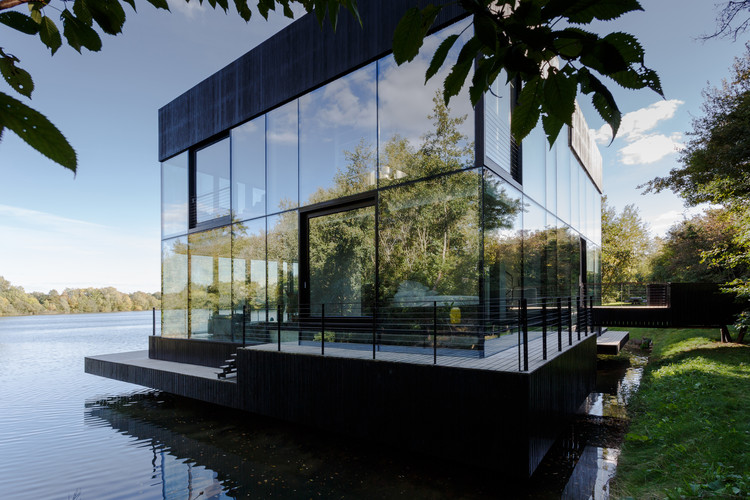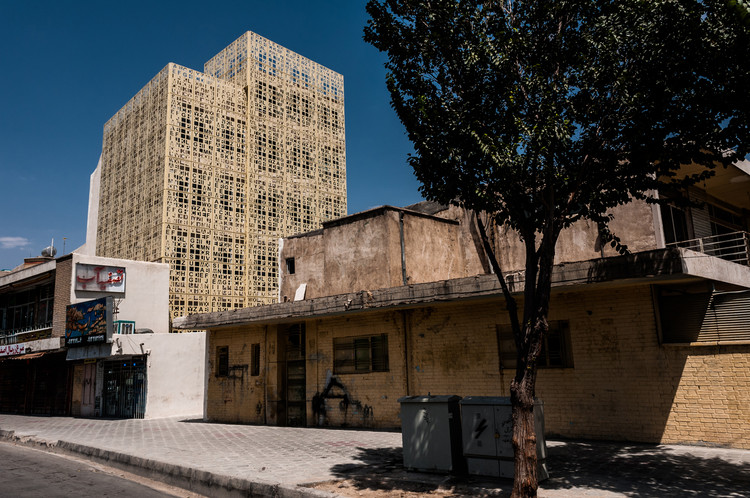Hannam
2015-03-17 23:00
© Yongkwan Kim
金永坤


架构师提供的文本描述。城市景观之间的关系。
Text description provided by the architects. The relationship between the urban landscapes.
大楼位于汉南大道104号,连接2号隧道和汉南大桥。作为交通拥堵最严重的街道之一,它定义了场地的特征。尽管该项目是一座小型建筑,但城市景观的定义是个问题,它成为了规划的起点。最后,探讨了在交通拥堵期间,建筑物内的使用者与车辆中的人之间的视觉交互作用。主要由城市景观组成的立面,不允许行人和车辆之间进行任何视觉交流。这个项目是要脱离单方面的沟通,在这种情况下,只有建筑物内的用户才能看到外面。环境(行人、居民)与建筑之间的自然、视觉交流将重新评价构成城市景观的建筑的特征。
The building is located on 104 Hannam Blvd., which connects the Tunnel 2 and Hannam Bridge. As one of the streets with the most traffic congestion, it has defined the characteristic of the site. Even though the project is a small building, defining the urban landscape was the question and it became the starting point for the plan. In conclusion, the visual interaction between the users in the building and those, people in the car, on the street during traffic congestions was explored. The facade, which mostly composes the urban scenery, does not allow any visual communication between the pedestrians nor the vehicles. This project is to depart from the unilateral communication where only the users in the building are allowed to look out. The natural, visual communication between the environment (pedestrians, residents) and the architecture will reevaluate the characteristics of the architectures that comprise the urban landscape.
© Yongkwan Kim
金永坤


城市办公空间的可持续性。
Sustainability of the office spaces in the city.
这座大楼的用途是为了办公室。我们中的许多人每天在封闭的办公空间里花费8多个小时,就像生活在栅栏里的牲畜一样。为了解放大楼内的用户,在所有办公空间旁边规划了一个阳台。小阳台可以容纳两到三个人的谈话空间,私人空间用于电话交谈,并最终允许用户呼吸新鲜空气。这些阳台可以想象成漂浮的公园。城市内的阳台是体验城市的关键。此外,办公室用户在心理上将大大受益,因为办公空间密度的降低也将减少累积的疲劳。正面结构
The purpose of the building is for the offices. Many of us spend more than 8 hours per day in the enclosed office spaces which can be resembled as livestock living inside a fence. To free the users in the building, a balcony is planned adjacent to all of the office spaces. Small balconies would allow the space for two to three person conversation spaces, private spaces for phone conversations, and ultimately allow the users to breathe some fresh air. These balconies can be visualized as floating park. The balcony within a city is the key to experience the city. In addition, the office users would significantly benefit psychologically as the decreased density in the office spaces would, also, reduce the accumulated fatigue. Facade Structure.
© Yongkwan Kim
金永坤


为了创造阳台,外壳变成了结构。主体结构和子结构的二重性使得结构构件要么合并,要么分割,在结构之间形成空隙,形成阳台。这是类似的肋骨结构,它发展从哥特式建筑,以创造一个拱形天花板。阳台之间的波浪被重复,以区分楼层;它是系统的,但计划制造一个不规则。建筑物的足迹增加了,因为阳台增加了办公空间。消除正面的边缘导致建筑物的外壳被认为是表面。
To create the balconies, the outer shell became the structure. The duality of main structure and sub-structure allowed the structural members to either merge or divide, and create void space between structures to form the balconies. This is similar to the rib structure which developed from the Gothic architecture to create a vaulted ceiling. The waves between the balconies are repeated to differentiate the floors; it is systematic but planned to create an irregularity. Footprint of the building has increased as the balconies were additions to the office spaces. Elimination of the facade¡¯s edge led the outer shell of the building to be recognized as a surface.
© Yongkwan Kim
金永坤


混凝土的操纵。
Manipulation of concrete.
为构建三维曲面立面结构系列,研制了钢板分模系统.混凝土被浇筑到三维模具中,这就要求铸件在拐点处分离。分流模的性质要求混凝土按段浇筑.它必须倒在一个部分,然后在镜像的顶部部分。颜色编码方法使现场工作人员更容易理解过程,为施工人员创造了新的工作环境。
A steel plate split-mold system was fabricated to construct the series of 3-dimensional curved facade structure. The concrete was poured into the 3-dimensional mold which required the cast to be separated at the inflection point. The nature of the split-mold required the concrete to be poured by section. It had to be poured at one section then onto the mirrored top section. The method of color coding helped the field workers to easily understand the process, which also created a new working environment for the construction crew.
© Yongkwan Kim
金永坤


.jpg)

通过透视改变外观。
Change of the facade through perspective.
前面的立面并不显示建筑的三维方面,但是,随着视角的变化,体验发生了巨大的变化。这种模式类似于OP艺术,其中最主要的因素是观察者的观点。从长远来看,这给行人和开车的人带来了非常不同的建筑体积体验。我们可以想象路人(当他们看大楼的时候)和使用者(站在阳台上)的短暂交流。这将给那些没有表现力的城市景观带来一点快乐。
The front elevation does not reveal the 3-dimensional aspect of the building; however, as the perspective changes, the experience changes dramatically. This pattern is similar to op art where the main factor is on the observer¡¯s perspective. In extend, this brings very different experiences of the volume of the building to the pedestrians then to those driving in the car. We can imagine the short communication of the passerby¡¯s (as they glance at the building) and the users (standing at the balcony). This would bring a small joy to those of expressionless urban landscape.
© Yongkwan Kim
金永坤


































.jpg)

.jpg)

.jpg)

.jpg)

.jpg)

.jpg)

.jpg)



.jpg)

.jpg)



.jpg)

.jpg)

.jpg)

.jpg)

.jpg)

.jpg)

.jpg)

.jpg)

Architects THE_SYSTEM LAB
Location 104 Hannam-daero, Yongsan-gu, Seoul, South Korea
Category Offices Interiors
Design Team Choonglyeol Lee, Sanghyun Park, Jongkil Kim, Jinchul Choi
Design Chanjoong Kim
Area 433.0 sqm
Project Year 2014
Photographs Yongkwan Kim
























